学习材料 英语阅读的猜词技巧
- 格式:doc
- 大小:17.00 KB
- 文档页数:6

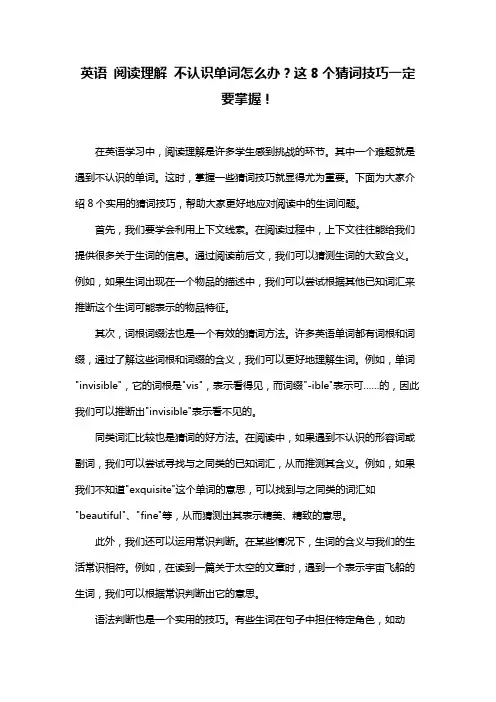
英语阅读理解不认识单词怎么办?这8个猜词技巧一定要掌握!在英语学习中,阅读理解是许多学生感到挑战的环节。
其中一个难题就是遇到不认识的单词。
这时,掌握一些猜词技巧就显得尤为重要。
下面为大家介绍8个实用的猜词技巧,帮助大家更好地应对阅读中的生词问题。
首先,我们要学会利用上下文线索。
在阅读过程中,上下文往往能给我们提供很多关于生词的信息。
通过阅读前后文,我们可以猜测生词的大致含义。
例如,如果生词出现在一个物品的描述中,我们可以尝试根据其他已知词汇来推断这个生词可能表示的物品特征。
其次,词根词缀法也是一个有效的猜词方法。
许多英语单词都有词根和词缀,通过了解这些词根和词缀的含义,我们可以更好地理解生词。
例如,单词"invisible",它的词根是"vis",表示看得见,而词缀"-ible"表示可……的,因此我们可以推断出"invisible"表示看不见的。
同类词汇比较也是猜词的好方法。
在阅读中,如果遇到不认识的形容词或副词,我们可以尝试寻找与之同类的已知词汇,从而推测其含义。
例如,如果我们不知道"exquisite"这个单词的意思,可以找到与之同类的词汇如"beautiful"、"fine"等,从而猜测出其表示精美、精致的意思。
此外,我们还可以运用常识判断。
在某些情况下,生词的含义与我们的生活常识相符。
例如,在读到一篇关于太空的文章时,遇到一个表示宇宙飞船的生词,我们可以根据常识判断出它的意思。
语法判断也是一个实用的技巧。
有些生词在句子中担任特定角色,如动词、名词等。
通过了解句子结构和生词在句子中的作用,我们可以推测出其含义。
例如,如果生词在一个句子中作谓语,那么它很可能是一个表示动作的动词。
图片或图表辅助法在阅读理解中也很实用。
有些文章会配有图片或图表,通过观察这些视觉辅助材料,我们可以更好地理解生词的含义。
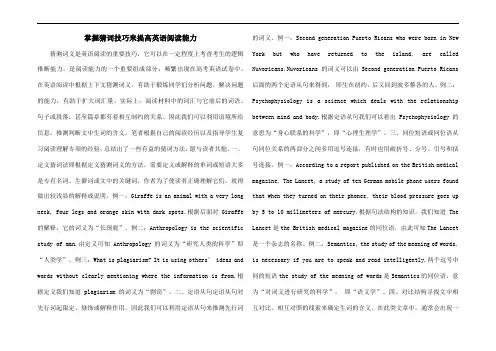
掌握猜词技巧来提高英语阅读能力猜测词义是英语阅读的重要技巧,它可以在一定程度上考查考生的逻辑推断能力,是阅读能力的一个重要组成部分,频繁出现在高考英语试卷中。
在英语阅读中根据上下文猜测词义,有助于锻炼同学们分析问题、解决问题的能力,有助于扩大词汇量。
实际上,阅读材料中的词汇与它前后的词语、句子或段落,甚至篇章都有着相互制约的关系。
因此我们可以利用语境所给信息,推测判断文中生词的含义。
笔者根据自己的阅读经历以及指导学生复习阅读理解专项的经验,总结出了一些有益的猜词方法,愿与读者共勉。
一、定义猜词法即根据定义猜测词义的方法。
需要定义或解释的单词或短语大多是专有名词、生僻词或文中的关键词,作者为了使读者正确理解它们,就得做出较浅显的解释或说明。
例一:Giraffe is an animal with a very long neck, four legs and orange skin with dark spots.根据后面对 Giraffe 的解释,它的词义为“长颈鹿”。
例二:Anthropology is the scientific study of man.由定义可知 Anthropology 的词义为“研究人类的科学”即“人类学”。
例三:What is plagiarism? It is using others’ ideas and words without clearly mentioning where the information is from.根据定义我们知道plagiarism的词义为“剽窃”。
二、定语从句定语从句对先行词起限定、修饰或解释作用,因此我们可以利用定语从句来推测先行词的词义。
例一:Second generation Puerto Ricans who were born in New York but who have returned to the island, are called Nuvoricans.Nuvoricans 的词义可以由Second generation Puerto Ricans 后面的两个定语从句来得到,即生在纽约,后又回到波多黎各的人。
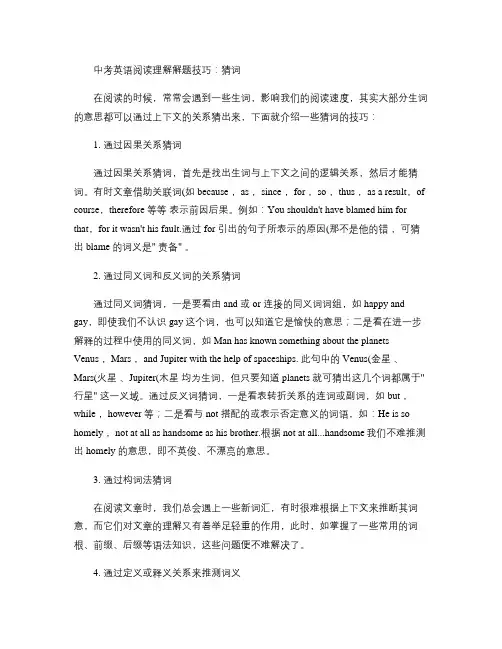
中考英语阅读理解解题技巧:猜词在阅读的时候,常常会遇到一些生词,影响我们的阅读速度,其实大部分生词的意思都可以通过上下文的关系猜出来,下面就介绍一些猜词的技巧:1. 通过因果关系猜词通过因果关系猜词,首先是找出生词与上下文之间的逻辑关系,然后才能猜词。
有时文章借助关联词(如because ,as ,since ,for ,so ,thus ,as a result,of course,therefore 等等表示前因后果。
例如:You shouldn't have blamed him for that,for it wasn't his fault.通过for 引出的句子所表示的原因(那不是他的错,可猜出blame 的词义是" 责备" 。
2. 通过同义词和反义词的关系猜词通过同义词猜词,一是要看由and 或or 连接的同义词词组,如happy and gay,即使我们不认识gay 这个词,也可以知道它是愉快的意思;二是看在进一步解释的过程中使用的同义词,如Man has known something about the planetsVenus ,Mars ,and Jupiter with the help of spaceships. 此句中的Venus(金星、Mars(火星、Jupiter(木星均为生词,但只要知道planets 就可猜出这几个词都属于" 行星" 这一义域。
通过反义词猜词,一是看表转折关系的连词或副词,如but ,while ,however 等;二是看与not 搭配的或表示否定意义的词语,如:He is so homely ,not at all as handsome as his brother.根据not at all...handsome我们不难推测出homely 的意思,即不英俊、不漂亮的意思。
3. 通过构词法猜词在阅读文章时,我们总会遇上一些新词汇,有时很难根据上下文来推断其词意,而它们对文章的理解又有着举足轻重的作用,此时,如掌握了一些常用的词根、前缀、后缀等语法知识,这些问题便不难解决了。
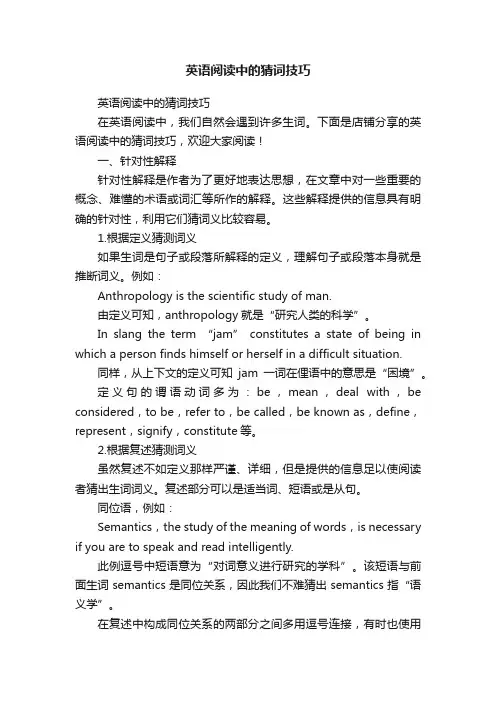
英语阅读中的猜词技巧英语阅读中的猜词技巧在英语阅读中,我们自然会遇到许多生词。
下面是店铺分享的英语阅读中的猜词技巧,欢迎大家阅读!一、针对性解释针对性解释是作者为了更好地表达思想,在文章中对一些重要的概念、难懂的术语或词汇等所作的解释。
这些解释提供的信息具有明确的针对性,利用它们猜词义比较容易。
1.根据定义猜测词义如果生词是句子或段落所解释的定义,理解句子或段落本身就是推断词义。
例如:Anthropology is the scientific study of man.由定义可知,anthropology就是“研究人类的科学”。
In slang the term “jam” constitutes a state of being in which a person finds himself or herself in a difficult situation.同样,从上下文的定义可知jam一词在俚语中的意思是“困境”。
定义句的谓语动词多为:be,mean,deal with,be considered,to be,refer to,be called,be known as,define,represent,signify,constitute等。
2.根据复述猜测词义虽然复述不如定义那样严谨、详细,但是提供的信息足以使阅读者猜出生词词义。
复述部分可以是适当词、短语或是从句。
同位语,例如:Semantics,the study of the meaning of words,is necessary if you are to speak and read intelligently.此例逗号中短语意为“对词意义进行研究的学科”。
该短语与前面生词semantics是同位关系,因此我们不难猜出semantics指“语义学”。
在复述中构成同位关系的两部分之间多用逗号连接,有时也使用破折号、冒号、分号、引号和括号等。
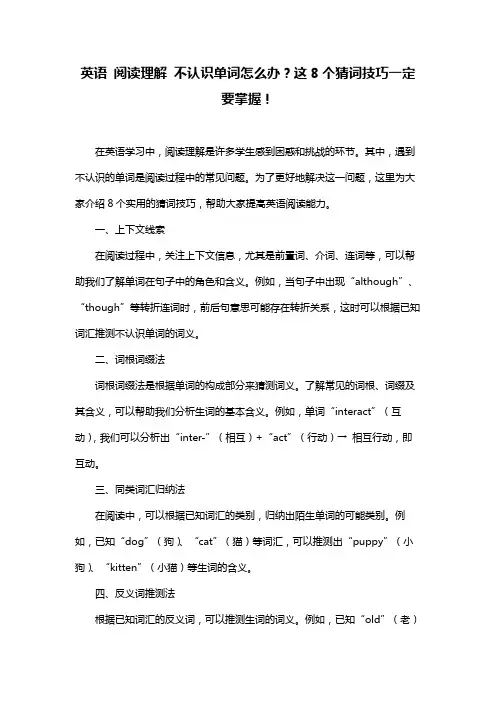
英语阅读理解不认识单词怎么办?这8个猜词技巧一定要掌握!在英语学习中,阅读理解是许多学生感到困惑和挑战的环节。
其中,遇到不认识的单词是阅读过程中的常见问题。
为了更好地解决这一问题,这里为大家介绍8个实用的猜词技巧,帮助大家提高英语阅读能力。
一、上下文线索在阅读过程中,关注上下文信息,尤其是前置词、介词、连词等,可以帮助我们了解单词在句子中的角色和含义。
例如,当句子中出现“although”、“though”等转折连词时,前后句意思可能存在转折关系,这时可以根据已知词汇推测不认识单词的词义。
二、词根词缀法词根词缀法是根据单词的构成部分来猜测词义。
了解常见的词根、词缀及其含义,可以帮助我们分析生词的基本含义。
例如,单词“interact”(互动),我们可以分析出“inter-”(相互)+“act”(行动)→ 相互行动,即互动。
三、同类词汇归纳法在阅读中,可以根据已知词汇的类别,归纳出陌生单词的可能类别。
例如,已知“dog”(狗)、“cat”(猫)等词汇,可以推测出“puppy”(小狗)、“kitten”(小猫)等生词的含义。
四、反义词推测法根据已知词汇的反义词,可以推测生词的词义。
例如,已知“old”(老)为“young”(年轻)的反义词,那么遇到“senior”(高级)时,可以猜测其与“junior”(初级)为反义关系。
五、常识判断法在阅读过程中,可以根据生活常识和所学知识来判断生词的含义。
例如,在描述食物的文章中,遇到“baguette”(法棍面包)这个生词,可以根据法国美食的常识来判断其词义。
六、语法分析法分析句子结构和语法规则,可以帮助我们了解生词在句子中的作用。
例如,当生词位于名词所有格或双重所有格时,可以猜测其为某个名词的属性或所有物。
七、联系生活实际法将生词与现实生活中的事物、情境相联系,可以帮助我们更好地理解词义。
例如,在学习科技文章时,遇到“nanometer”(纳米)这个生词,可以联系生活中的纳米材料、纳米技术等实际例子来推测其含义。
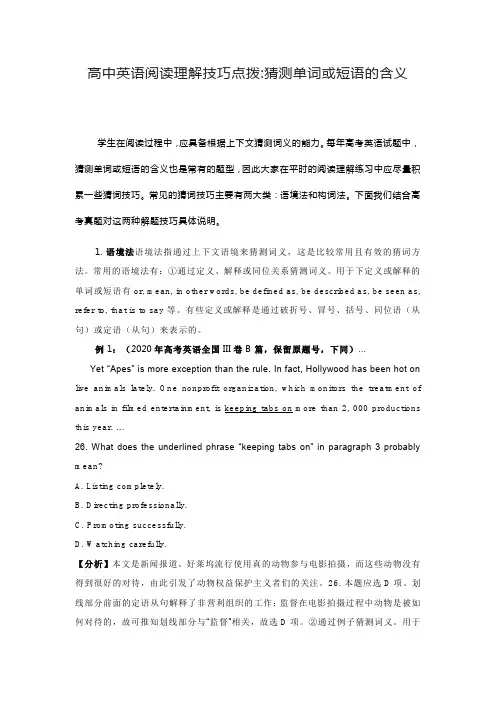
高中英语阅读理解技巧点拨:猜测单词或短语的含义学生在阅读过程中,应具备根据上下文猜测词义的能力。
每年高考英语试题中,猜测单词或短语的含义也是常有的题型,因此大家在平时的阅读理解练习中应尽量积累一些猜词技巧。
常见的猜词技巧主要有两大类:语境法和构词法。
下面我们结合高考真题对这两种解题技巧具体说明。
1. 语境法语境法指通过上下文语境来猜测词义,这是比较常用且有效的猜词方法。
常用的语境法有:①通过定义、解释或同位关系猜测词义。
用于下定义或解释的单词或短语有or, mean, in other words, be defined as, be described as, be seen as, refer to, that is to say 等。
有些定义或解释是通过破折号、冒号、括号、同位语(从句)或定语(从句)来表示的。
例1:(2020年高考英语全国III卷B篇,保留原题号,下同)...Yet “Apes” is more exception than the rule. In fact, Hollywood has been hot on live animals lately. One nonprofit organization, which monitors the treatment of animals in filmed entertainment, is keeping tabs on more than 2, 000 productions this year. ...26. What does the underlined phrase “keeping tabs on” in paragraph 3 probably mean?A. Listing completely.B. Directing professionally.C. Promoting successfully.D. Watching carefully.【分析】本文是新闻报道。
![高三英语阅读理解猜词技巧[课件]](https://uimg.taocdn.com/04d6dca7aaea998fcc220e8a.webp)

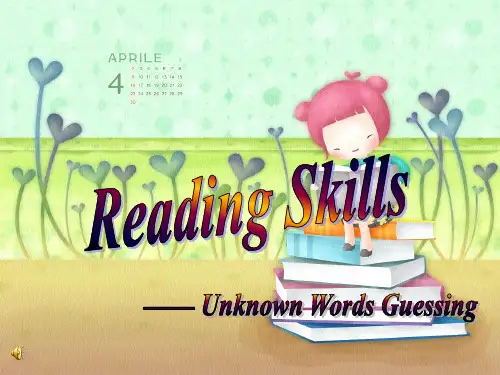

2023年高考英语阅读理解专题04 猜词题专题04 猜词题Part1 技巧导图Part2 知识详解Part3 词义猜测题特点Part4 词义猜测题七大猜词技巧Part5 构词法基础知识Part1 技巧导图Part2 知识详解Part3 词义猜测题特点猜词悟义是应用英语的重要能力,也是高考阅读理解中必考的题型。
它不但需要准确无误地理解上下文,而且要有较大的泛读量,掌握或认识较多的课外词汇。
同时,考生应掌握一些猜词技巧,通过定义、同位、对比、因果、常识、同义、反义、构词、常识及上下文线索等确定词义。
词义猜测题思维导图【设问形式】•The underlined word “ … ” refers to/ (probably) means .•“…” as used in the passage can best be defined as…•What do you think the expression “…” stands for?•What does the underlined word “…” refer to in the last paragraph?•Which of the following words can take the place of the word “ … ”?•The underlined word “…” could best be replaced by…•Which of the following has the closest meaning to the word “ … ”?•What does the author mean by “…” in paragraph 2?Part4 词义猜测题七大猜词技巧1.根据定义或上下文解释进行猜测有时短文中出现一个需要猜测其意义的词或短语,下面接着出现其定义或解释。
标点符号,如逗号后的解释(名词同位语)、破折号后的解释、括号内的解释等。
中考英语阅读理解猜词题解题技巧一、了解猜词题的基本要求猜词题是中考英语阅读理解题中常见的一种题型,通常要求考生根据上下文和语墅提示来猜测词语的意思。
考生在解答猜词题时,需要具备一定的词汇量和语境分析能力,同时还需要掌握一些解题技巧,才能更好地完成这类题目。
二、掌握常见的猜词技巧1. 根据上下文猜测词义猜词题通常会提供一段上下文,考生需要根据上下文的逻辑关系和语墅提示来猜测词语的意思。
在猜测词义时,可以通过理解段落主题、分析句子结构、推断逻辑关系等方法来获取线索,进而推测词语的含义。
在以下句子中:“He is a very diligent student and always finishes his homework on time.”我们可以通过上下文来猜测diligent的意思,因为上文提到他是一个“非常勤奋的学生”,所以diligent的意思可能是勤奋的、努力的。
2. 利用语境提示进行词义推断除了根据上下文猜测词义外,还可以利用语境提示进行词义推断。
比如一些词语的前后文会提供一些提示性的词语,这些提示性词语往往可以帮助我们推测目标词语的意思。
在以下句子中:“W hen the teacher asked a difficult question, the students looked puzzled.”我们可以通过后面的“looked puzzled”来推测difficult的意思,因为学生们显然是对这个问题感到困惑。
3. 掌握常见词义辨析技巧在解答猜词题时,有些词语的词义可能会让考生感到困惑,这时就需要掌握一些词义辨析技巧。
比如通过对比近义词或反义词的意思,来推测目标词语的含义。
在以下句子中:“The music was so loud that it was almost deafening.”我们可以通过对比loud和deafening的意思,来推测deafening的含义,因为loud表示“大声的”,而deafening应该表示“震耳欲聋的”。
英语阅读理解不熟悉不认识单词猜词技巧1类属法即通过类属来推测词义。
如:■ Bananas,oranges, pineapples, coconuts and some other kinds of fruit grow in warm areas.说明:从句意我们知道pineapples 和coconuts 与bananas, oranges是同类事物,同属水果(准确地说是“菠萝”和“椰子”)。
2推理法即根据文章的前后语境推出生词的词义。
如:■That museum is so immens e that it will be impossible to see all the exhibits in one day.说明:既然一天之内看不完所有的展品,那么immense 的意思应该是“很大”了。
■Everyone agreed that the woman in the photo was gorgeous. It was easy to see why she had won the beauty contest.说明:既然“她在选美比赛中获胜”,说明她“很美丽”(gorgeous)。
3列举法即通过对文章所列举的事物来猜测生词的词义。
如:■Children like such creatures as dogs and monkeys.说明:像dogs 和monkeys 之类的“creatures”,显然creatures的意思应是“动物”。
■In your spare time, you may look through any of these periodicals: TimeMagazine, News Week, or The New Worker.说明:periodical是生词,但根据其后所列举的例子,我们可以推测出它的意思可能是“期刊”或“杂志”。
4构词法即根据前缀、后缀、复合、派生等构词知识判断生词的词义。
高考英语阅读理解猜测词义题解题技巧高考英语阅读理解猜测词义题解题技巧导语:阅读材料中的每个词与它前后的词语或句子甚至段落都有联系。
下面就由小编为大家介绍高考英语阅读理解猜测词义题解题技巧,大家一起去学习吧!猜测词义题解题技巧在阅读中我们经常会遇到许多生词。
这时许多同学立即翻阅词典,查找词义。
这样做不但费时费力,而且影响阅读速度、影响对语篇的整体把握。
事实上,阅读材料中的每个词与它前后的词语或句子甚至段落都有联系。
我们可以利用语境(各种已知信息)推测、判断某些生词的词义。
近年来全国统一高考中加大了对考生猜词义能力的考查,因此,掌握一定的猜词技巧,对突破高考阅读理解、提高我们的英语语言能力都有非常重要的意义。
这种题常见的提问方式有:The word “…” in paragraph … can best be replaced by … ….The underlined word “…” most probably means ….By saying “…”, the author means …The expression “…” is closest to …According to the passage, the phrase “…” suggests …The underlined part “… …” (in Para. … ) means …..做这种类型的题,要根据词、词组、句子所在的语境来判断其意义。
因此熟练掌握一些猜词技巧是做好这类题的关键。
命题者在出这类题时惯用常规词义来麻痹考生,我们要特别注意熟词生义,切不可脱离语境想当然。
猜测词义时,一般可利用以下三个方面的线索:一.针对性的解释针对性解释是作者为了更好的表达思想,在文章中对一些重要的概念、难懂的术语或高深的词汇等所做的通俗化的解释。
这些解释提供的信息明确具体,所使用的语言通俗易懂,利用它们来猜测词义就非常简单。
1.根据定义(definition)猜测词义如果生词有一个句子或段落来定义,那么理解这个句子或段落本身就是推断词义。
高考英语阅读理解九大猜词技巧1.利用定义或解释(definition or explanation)Signal words: means, refers to, be called, be known as ,can be defined as, in other words,that is , that is to say, 定语从句…..etc.举例:Pruning is important because it encourages the growth of tender shoots(嫩芽), or young leaves of trees.(B)The word "pruning" means______A. Regular cutting(修剪)of the plantsB. Frequent wateringC. Regular use of chemicalsD. Growing the plants high in the mountain2.利用普通常识和经验(common sense or experience)举例:1. In fact, only about 80 ocelots, an endangered wild cat, exist in the U.S. today."ocelot" means _________________(an endangered wild cat)2.The period of adolescence, the period between childhood and adulthood ,may be long or short."adolescence" means___________(The period between childhood and adulthood)3.利用同义/同位语(similarity/appositive)Signal words:for example ,for instance,such as ,like,as---as,etc.举例:The largest player –Shanghai Bashi Tourism Car Center offers a wide variety of choices, such as deluxe sedans, minivans, station wagons, coaches. Santana sedans are the big favorite of the tourists. (C)The words "deluxe sedans," "minivans" and "station wagons" used in the text refer to ____.A. cars in the makingB. car rental firmsC. cars for rentD. car makers4.利用举例(from examples)Signal words: as, like, the same as,unlike, but,however, on the contrary, while,instead…ect.举例:1. The snow was falling.Big flakes drifted(飘)with the wind like feathers.2. Unlike her gregarious sister, Jane is a shy person who does not like to go to parties or make new friends.5.利用比较或对比(comparison or contrast)(1)Overwork may cause diseases.over(过分的、过量的)+work=overwork“工作过度”。
英语阅读猜词技巧Reading is a fundamental skill that is essential for success in many areas of life. Whether you are a student, a professional, or simply someone who enjoys learning, being able to read and comprehend written material is crucial. One aspect of reading that can be particularly challenging is the ability to guess the meaning of unknown words. This skill, often referred to as "guessing vocabulary," is a valuable tool that can help you become a more proficient and confident reader.Guessing vocabulary is the process of using contextual clues, word roots, and other strategies to determine the meaning of unfamiliar words encountered while reading. This technique can be particularly useful when reading in a foreign language, such as English, where the vocabulary can be vast and complex. By developing the ability to guess the meaning of unknown words, you can improve your overall reading comprehension and expand your vocabulary.One of the key strategies for guessing vocabulary is to pay attention to the context in which the word is used. By examining thesurrounding sentences, you can often infer the meaning of the unfamiliar word based on the information provided. For example, if you come across the word "diligent" in a sentence that describes someone who works hard and is dedicated to their tasks, you can reasonably conclude that "diligent" means "hardworking" or "devoted."Another useful technique for guessing vocabulary is to look for word roots, prefixes, and suffixes. Many words in the English language are derived from Latin or Greek roots, and understanding these roots can provide valuable clues about the meaning of the word. For instance, the prefix "re-" often indicates a repetition or reversal of an action, as in the word "reread," which means to read something again. By recognizing these linguistic patterns, you can develop a more intuitive understanding of the meaning of unfamiliar words.In addition to using contextual clues and word roots, you can also employ strategies such as identifying parts of speech, recognizing cognates (words that are similar in two languages), and making connections to words you already know. By combining these various techniques, you can increase your chances of accurately guessing the meaning of unknown words.Developing the skill of guessing vocabulary can have numerous benefits. First and foremost, it can significantly improve your readingcomprehension. When you are able to determine the meaning of unfamiliar words, you can better understand the overall message or content of the text. This, in turn, can enhance your ability to engage with and learn from the material you are reading.Moreover, the ability to guess vocabulary can also expand your overall language proficiency. As you encounter and successfully decipher more unfamiliar words, your vocabulary will grow, making you a more confident and capable communicator. This can be particularly advantageous in academic or professional settings, where the ability to understand and use a wide range of vocabulary is highly valued.Furthermore, guessing vocabulary can make the reading process more enjoyable and engaging. Instead of feeling frustrated or discouraged by unknown words, you can approach them as intellectual challenges to be solved. This mindset can foster a sense of curiosity and excitement about the reading experience, leading to a deeper appreciation for the written word.To effectively develop the skill of guessing vocabulary, it is important to practice regularly and be willing to take risks. When you encounter an unfamiliar word, don't simply skip over it or look up the definition immediately. Instead, take a moment to examine the context, analyze the word's structure, and make an educated guess.Even if your initial guess is incorrect, the process of attempting to decipher the word can still be valuable, as it reinforces the strategies you are learning.It's also helpful to keep a record of the words you have successfully guessed, as well as any new vocabulary you have learned through this process. This can serve as a reference point and a way to track your progress over time. Additionally, you can challenge yourself by trying to guess the meaning of unfamiliar words in increasingly complex or specialized texts, such as academic articles or technical manuals.In conclusion, the ability to guess vocabulary is a crucial skill for effective reading and language acquisition. By leveraging contextual clues, word roots, and other strategies, you can improve your reading comprehension, expand your vocabulary, and make the reading process more engaging and enjoyable. Embracing the challenge of guessing unknown words can not only enhance your academic or professional performance but also foster a lifelong love of learning and exploration through the written word.。
英语阅读中的猜词技巧文/李进才在阅读英语文章时,常常会碰到一些生词,这是无法避免的。
如果一遇到生词就翻词典,这在很大程度上影响了我们的阅读速度,而且在出现几回这样的“停顿”之后,我们难免会感到趣味索然,心烦意乱,从而中止阅读。
如果遇到生词不翻词典,这势必会造成一些词义理解上的困难,从而妨碍我们对文章的正确理解,同时也达不到通过阅读文章获得信息的目的。
但是“会读”的人总能通过上下文准确地猜出一些生词的含义,这决非他有什么特异功能,而是巧妙地运用了“猜词”的技巧。
在此,笔者结合自己多年的教学经验就英语阅读过程中的猜词技巧做一简单介绍,希望能对大家今后的英语阅读有所帮助。
一般情况下,培养猜词技巧、提高猜词能力可以从以下几方面入手:一、利用提示词猜词英语中的提示词能帮助读者推断词义,主要的提示词有表示定义关系的is(are),mean, (be)called 等和表示同位语关系的that is,or, i.e.,such as,in other words,namely, put another way等。
比如:1Numbers such as 1,2,3,4,10,100 are called whole numbers,or integers.“integer”是生词,但从整个句子来看,“integers”其实就是“whole numbers”(整数)的同位语,所以“integer”的意思是:整数。
2The word“adolescence”means the period between children and adulthood.“adolescence”是生词,但我们根据它的定义可以猜出其含义:青春期。
3.A byline,that is,the line at the head of a newspaper article that tells the author’s name,is rarely given to an inexperienced reporter.“byline”是生词。
英语阅读的猜词技巧
在英语阅读中,公务员之家xx,全国公务员共同的天地!我们自然会遇到许多生词。
这时,许多人立即翻阅字典,查找词义。
其实,这种做法是不科学的。
它不但费时费力,而且影响阅读速度。
事实上,阅读材料中的每个词与它
前后的词语或句子甚至段落有着互相制约的关系。
我们可以利用语境(各种已知信息)推测、判
断某些生词的词义。
猜测词义时,可利用以下线索:
一、针对性解释
针对性解释是作者为了更好的表达思想,在文章中对一些重要的概念、难懂的术语或词汇等
所作的解释。
这些解释提供的信息具有明确的针对性,利用它们猜词义比较容易。
根据定义猜测词义
如果生词是句子或段落所解释的定义,理解句子或段落本身就是推断词义。
例如:
由定义可知,就是“研究人
类的科学”。
同样,从上下文的定义可知一词在俚语中的意思是“困境”。
定义句的谓语动词多为:
等。
根据复述猜测词义
虽然复述不如定义那样严谨、详细,但是提供的信息足以使阅读者猜出生词词义。
复述部分可以适当词、短语或是从句。
同位语
此例逗号中短语意为“对词意义进行研究的学科”。
该短语与前面生词式
同位关系,因此我们不难猜出指“语义学”。
在复述中构成同位关系的两部分之间多用逗号连接,有时也使用破折号,冒号,分号,引
号,和括号等。
由同位语我们很快猜出生词词义电容量。
需要注意的是:同位语前还常有
等副词或短
语出现。
定语从句
根据生词后面定语从句和同位语
我们可以推断出含义,即“季节
性情绪紊乱症”。
根据举例猜测词义
恰当的举例能够提供猜测生词的重要线索,例如:
句中“战争”
和“重大科学发现”是生词的实例,通过它们我们可以猜出的大
致词义“重要的”,这与
其确切含义“划时代的”十分接近。
二、内在逻辑关系
根据内在逻辑关系推测词义是指运用语言知识分析和判断相关信息之间存在的逻辑关系然后
根据逻辑关系推断生词词义或大致义域。
根据对比关系猜测词义
在一个句子或段落中,有对两个事物或现象进行对比性的描述,我们可以根据生词或难词的
反义词猜测其词义。
例如:
该例中对许多人来说可能是个生词,但是句中短语,(相对照的,相对比的)可以提示我们和后面词组(谦卑又谦虚)是对比关
系。
分析出这种关系后,我们便能猜出意为“目空一切的,傲慢的”。
表示对比关系的词汇和短语主要是,,,,,,
和引导的并列句等。
该句中并未出现上面提到的表示对比关系的词或短语,但是通过上下文可以判断出句子前后
是对比关系,即把熟练工人与非熟练工人区分开。
公务员之家xx,全国公务员共同的天地!这时我们也能够推断出生词的词义,“熟练的”。
根据比较关系猜测词义
同对比关系相反,比较关系表示意义上的相似关系,例如:,
该句中副词表明短语与生词之间的比较关系。
以此可以
推断出词义为“健谈的”。
表示比较关系的词和短语主要是,,,等。
根据因果关系猜测词义
在句子或段落种,若两个事物、现象之间构成因果关系,我们可以根据这种逻辑关系推知生
词词义。
例如:
根据原因状语从句的内容,我们可以推断出生词指“独断专行的”。
此句为结果状语从句,根据从句的描书“许多示威者”,我们便可推知
的词意“挤,挤过”。
根据同义词的替代关系猜测词义
在句子或段落种,我们可以利用熟悉的词语,根据语言环境推断生词词义。
例如:
作者为避免重复使用一词,用其同义词来替代它,由此推知其词义为
“使陷入危险,危及、危害”。
句中四个生词,但判断出替代后,不难推断出其词义为“不
利的,有害的”。
三、外部相关因素
外部相关因素是指篇章句子或段落以外的其他知识。
有时仅靠分析篇章内在逻辑关系无法
猜出词义。
这时就需要运用生活经验和普通常识确定词义。
例如:根据生活经验,天气寒冷时,手肯定是“冻僵的,冻得麻木的”。
根据有关蛇的生活习性的知识,我们可以推断出
词义为“爬行”。
在猜测词义过程中,除了使用上面提到的一些技巧,我们还可以依靠构词方面的知识,从生
词本身猜测词义。
根据前缀猜测词义例如:
根据词根(清醒的,有意识的),结合前缀(半,部分的,不完全的),
我们便可猜出词义“半清醒的,半昏迷的”。
词根意为“有文化修养的,通晓的”,前缀表示否定,因此指“一窍
不通,不知道的”。
根据后缀猜测词义
例如:
后缀表示“杀者,杀灭剂”,结合大家熟悉的词根(昆虫),不难猜出
意为“杀虫剂”。
后缀表示“小的”,词根指“滴,滴状物”。
将两个意思结合起来,
便可推断出
词义“小滴,微滴”。
根据复合词的各部分猜测词义
例如:
或许是一个生词,但是分析该词结构后,就能推测出其含义。
它是由(高
的,强的)和(光线)两部分组成,合在一起便是“以强光照射,使突出”的意思。
(公牛)和(打,搏斗)结合在一起,指一种在西班牙颇为流行的体育运动斗
牛。
综上所述,利用各种已知信息推测、判断词义是一项重要的阅读技巧。
在实践中,我们可以
灵活运用,综合运用上面提到的几种猜测技巧,排除生词的障碍,顺利理解文章的思想内容,提
高阅读速度。
内容仅供参考。